It's only been five months since I wrote an article asking for some action on the polarized state in which Pauper was at the time because of the rise of Chatterstorm and Sojourner's Companion, so I particularly didn't expect to have to write another article on bans anytime soon, and I've decided that I'm not going to write about Affinity.
I have two reasons for this:
The first is that, particularly, Pauper has not been the most exciting format for me for a long time, and with each new release, I feel more distant and less interested in the format for some obvious reasons, such as the inclusion of cards/mechanics that clearly break the competitive scene, while the very nature of the format, since before Commander Legends, is not the most exciting for the types of games I enjoy playing. So, despite playing periodically at local or online events, the format hasn't been my main focus and has lost its place to Pioneer which, despite all the debate about decks like Izzet Phoenix and Naya Winota, have presented much more diversity than Pauper today.
Ad
The second reason is that I don't see any practical ways in which Pauper can be fixed in the near future. It doesn't matter if something from Affinity gets banned when the format's issue is at a much deeper layer, and it's been getting out of hand for over two years, making the format extremely unstable, often creating scenarios where an oppressive deck emerges, or where the Metagame becomes extremely tedious for a dozen reasons, ranging from standardization of resources to repetitive play patterns during a match development.
This is obviously not unique to Pauper, and can occur with any competitive format, but there are some points in this regard where it has been far more damaging to Pauper than for any other eternal format, particularly in the lack of speed and assertiveness to solve problems, even when they are caused by bugs in the digital platform, and it is very unpleasant to see that these changes only occur in the week before the big events, such as Showcases and Qualifiers.
My particular conception of Pauper is currently not good because the format is sick, full of chronic issues that manifest themselves recurrently, even when we say that it is "healthy", and that I don't see the prospect of better days, where the format receives due attention, taking place in the next year.
The Current Scenario: Affinity is Broken
In case you're not following the format, Affinity now makes up about 30% of Pauper's Metagame, which is an expected number for a “best deck” in the format, but its conversion to the Top 8 is the highest in the format by a significant margin.
As an example, look at the Top 16 decks on last Saturday and Sunday's Challenges.
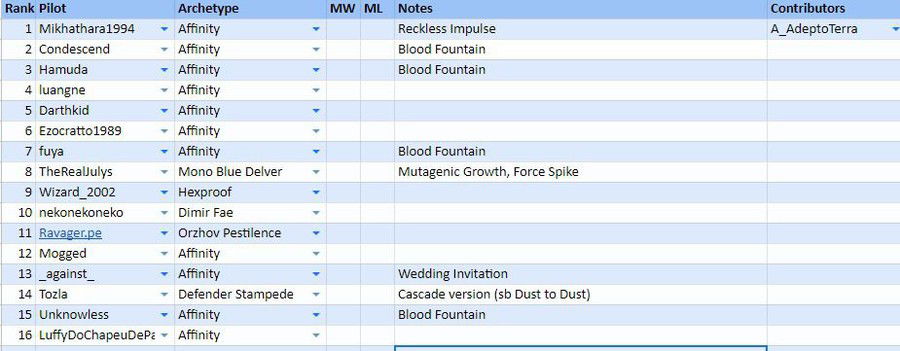
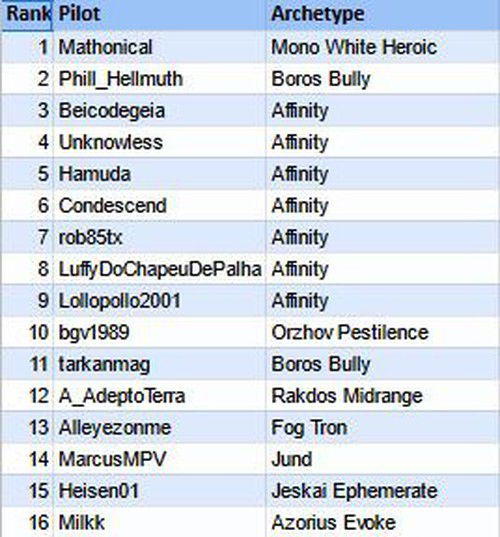
The Affinity variants (which are now mostly Grixis or Rakdos) occupied a total of thirteen of the sixteen Top 8 slots in this weekend's Challenges, and eighteen of the thirty-two Top 16 slots.
In addition, well-known archetypes are adopting several elements to deal with the current best deck and, even so, they continue to lose to Affinity, or they need to resort to an absurd number of answers on the sideboard, as was the case with the Challenge-winning Tron on November 13, which used a total of eleven cards on the Sideboard for the matchup against this archetype.
So, I think it's pretty evident to anyone who doesn't have a biased opinion for piloting the archetype, or for benefiting from its predominance (which, particularly, I don't think there's any other deck actually benefiting at the moment), that something needs to be banned from Affinity, and the discussion of what needs to be banned is quite a long one, and perhaps even deserves an article of its own, but I would like to bring your focus to a much more important issue, which is the source of the whole discussion of bans that we've been having since Fall from Favor and that all the interventions we've had recently been a consequence of this issue:
Ad
Problematic cards a Symptom, not the Disease
Remember the last time we had a consensus that Pauper was healthy and fun?
Even at times when the format was more diverse, such as after Fall from Favor's ban, there was still a huge debate over how many decks used Monarch, or how big Mana decks were suppressing other Midranges, or about how Cast Down and Snuff Out made Dimir Faeries too effective.
And if we look back, we've been debating the format's health negatively and, on most occasions, it's always been due to new cards since Peregrine Drake.
And in the face of so many debates about the health of a Metagame, the format has become an endless spiral of problems that only grows every year.
If bans occur on Affinity, we'll still be debating a number of other mechanics, decks, and interactions which are problematic for the format, and wondering when/if Wizards intends to take action on them, or if they'll let the format wither and need to fend for itself to deal with such issues.
Below is a list of many cards, decks, or mechanics not included in Affinity that are considered problematic for the format at some scale.
Keep in mind that they don't necessarily represent my particular view (although I agree with some of them):

Starting with Monarch, the mechanic is considered extremely parasitic for the format, as it standardizes card advantage, offers a resource that was not intended for two-players game, and favors less-interactive play styles where a player can simply avoid any and all opponent's attacks with removals/sweepers, fog effects and blockers, while burying them in a card avantage pile until they dominate the game.
Monarch started out as an interesting mechanic, which added a new way for Midrange decks to be able to stay in the format and keep up with the card selection established by the Blue-Based Decks, while also allowing for more interesting attrition games, while fast-paced decks like Stompy made playing with Monarch a risk, but it took players just a few years to “fix” the weaknesses in the mechanics, creating increasingly optimized archetypes, while several other strategies began to resort to Monarch.
Today, the mechanic have become pretty much mandatory in any non-Aggro/non-Tron Pauper decks, and even decks like Faeries runs two or three copies of Thorn of the Black Rose, or Crimson Fleet Commodore to maintain the card advantage against Midrange.
In short, when Pauper isn't polarized, it is heavily leaned towards Monarch.

A lot is said about Tron, especially about how unfun the archetype is to play against because of its soft locks and spell loops, and how problematic this archetype is for bringing a significant portion of games to a draw or to a 1-0 win in tabletop tournaments.
However, Tron's most obvious problem is that the archetype essentially limits the viability of Control decks in Pauper because no Control deck will be better than Tron, as it can break the mana math and make more plays in a single turn than any other deck that doesn't run Urza lands would.
Ad
In addition, Tron is another extremely limiting archetype, as it is a powerful natural predator of Midranges, while also managing to suppress most Aggro decks with its fog-effects and Stonehorn Dignitary soft-lock.
It's interesting to think, however, that Tron has been put in check recently because of Cleansing Wildfire's (also problematic) interaction with indestructible lands.

I've made a article where I explain how archetypes like Faeries will always be the best deck of the format when the Metagame is balanced, due to the advantages that a Turbo Xerox archetype naturally has in the game, but this does not mean that the predominance of the archetype should always be ignored, nor that it is not considered an issue in certain occasions.
At the end of the day, Spellstutter Sprite is still, as exemplified in the article, a Snapcaster Mage for Mental Misstep and later a Snapcaster Mage for Prohibit or even Counterspell, while its interaction with Ninja of the Deep Hours has been compelling since the early days of the format, and the fact that it's still present today and keeping up with mechanics like Monarch demonstrates how efficient this combination and the archetype are.
Actually, one of the reasons The Monarch still seems fair and necessary for Pauper is that the mechanic allows the other colors to keep up with the card advantage and top manipulation that the blue decks, especially Faeries and Delver (which isn't competitively viable today) possess.

There is currently debate over banning the new Indestructible Duals from Modern Horizons II, not only because of how much these cards helped make Affinity what it has become, but also because of their interaction with Cleansing Wildfire.
The combination of Cleansing Wildfire with these lands allows a player to have a two-mana ramp that resplaces itself in its controller's hand, while repairing his mana and speeding up his game plan, facilitating splashes and the like, therefore, an interaction comparable to the currently banned Arcum's Astrolabe, though far less splashable in other colors.
This interaction, in addition to the current dominance of Affinity, leads some players and content creators to believe that the entire MH2's dual land cycle should be banned.

Like Monarch, Bonder's Ornament is a card with the potential to standardize the card advantage between Midrange and Big Mana decks and, coupled with the artifact's proposed manafixing, worries some players that, in the absence of the Conspiracy mechanic, the card becomes a mandatory necessity on Midrange decks, and on the Sideboard of other decks to maintain card parity/counter their Ornaments.

Finally, there are several players who believe that Arcum's Astrolabe's ban should have been accompanied by Ephemerate because of the card's powerful interaction with Evoke, and with Stonehorn Dignitary and/ or Mnemonic Wall, and now, Ardent Elementalist, among the most diverse ETB effects that exist and will exist in Pauper.
Ad
In a world without Monarch, it's highly possible that Ephemerate starred in some of Card Advantage's major engines alongside Mulldrifter and other powerful cards such as Soul of Migration.
In addition to these, there are other cards that are vaguely considered problematic for Pauper, and there will definitely be many more in the coming years that will also be seen as an issue, or may even break the format again.
Or, more necessarily, Competitive Magic has kind of become a period where players enjoy the calm before the next storm of broken new mechanics and/or overwhelming deck.
Bans Won't Solve Everything
A common move by the Magic: The Gathering community recently has been the banalization of bans: many people, especially players, have a tendency to rate bans based on their personal taste, or particular dislike of a particular deck, or strategy, which is, honestly, a childish evaluation of any situation in a competitive game.
Many things can be considered when banning a card: Metagame representation, fun factor, game procedures (cards like Second Sunrise, Sensei's Divining Top and Cauldron Familiar were banned for presenting repetitive play patterns), among others, and it's unpredictable to know when Wizards deem it plausible to ban a card or not based on certain personal feelings, but if there's one thing I think we should always consider when talking about bans is the format's situation.
However, I think it's important to base your view on things based on data and the Metagame itself, not your personal feelings.
Alex Ullman, better known as NerdtotheCore does an impressive job of basing his particular opinions on the format's health with statistics and deck representation in each week's Challenges results and, despite my tendency to disagree with half of his claims regarding bans, I recognize and respect the amount of time and dedication he takes to analyze the format on a statistical basis.
Another content creator who does a fantastic job of presenting Pauper's Metagame stats is my countryman Álvaro França, captain of the Heavy Gears team, from MindGears, which went on hiatus recently, but has always done some great Metagame analysis.
Where many people, including many content creators fail to evaluate format, however, is the need to see facts for what they are, not what we would like them to be.
And the unfortunate reality from which I see is that even if we banned twenty or more cards, the format would remain problematic and/or it would only take to the next Masters or Horizons to break the format again because Magic has changed drastically, especially in the last three or four years, with the FIRE being applied in the most different aspects and increasing the individual power and effects of each card in every competitive format, as well as taking bolder measures with the formats, commonly bringing cards that end up being problematic for a competitive scenario, but also tens or hundreds of cards that positively impact the Metagame, and bring new ideas or reinforce lesser-known archetypes.
Ad
For example, we may be having a terrible time with Affinity right now, but have you stopped to realize that Mono-Red Blitz, thanks to Festival Crasher, Kessig Flamebreather, Ancestral Anger and Reckless Impulse, is becoming a real thing?
The same can be said of several other decks that emerged thanks to Ardent Elementalist, or Late to Dinner, or how Sarulf's Packmate became a staple for Cascade decks, or how First Day of Class brought a powerful but not unfair combo to Pauper with Moggwarts?
On the other hand, this significant increase in Power Level will bring problematic cards more often, so it becomes necessary to dose when a card really needs to be banned or not, and when an archetype is being oppressive or not because the game trend is that, in both common and Mythic-Rare slots, more and more powerful cards will be introduced over the years, and when we're always asking for direct interventions, we're trying to get back to a Pauper that just might not even exist more because the game has changed as a whole.
Also, it's understandable that while we're seeing more and more cards and more decks coming up, the format is still entrenched in the same “old” archetypes during this time: Faeries, Monarch, Tron, and Affinity, leaving little room for other decks to appear because they need to be very good to compete with such well-defined strategies and get their space in the Metagame, as happened with archetypes like Ephemerate, Cascade and Moggwarts, this is how competitive formats work.
Despite considering that there is still a lot of undiscovered potential in the format's interactions (a few years ago, Grixis Affinity would have been a joke compared to Temur versions and Rakdos would be unthinkable), Pauper is no longer the “brewer's paradise”, and it has its estabilished pillars that need to be respected when putting together your list.
It is also necessary to assess the impact that each change in the Metagame would cause with a direct intervention. How prevalent would Faeries become in Monarch's absence? What are the decks Tron keeps in check that could benefit from its banning? Would the departure of Spellstutter Sprite or Ninja of the Deep Hours make the format more diverse, or would it create another huge imbalance in the Metagame?
In other words, would banning some fundamental pillars make room for the Metagame's diversity, or for absolute chaos?
Unfortunately, there is no way to predict all outcomes and while I agree that mechanics like Monarch are parasitic and that the format could be better off without it, we also need to remember that there will always be best decks, and even if all the pillars of the format were banned today, others would emerge, and we would likely be having this same discussion again in six months or less.
Pauper has a nemesis, It's called Limited
The most frustrating part of this recurrent imbalance in the format's competitive landscape is that it doesn't come from deliberate action or planning gone wrong when producing a set, but from accidents that constantly occur because Limited defines Pauper's future.
Ad
In particular, the relationship between Pauper and Limited is strangely abusive: To improve draft and sealed, certain cards dangerous to the format are placed in the common slots because they promote an interesting and fun play styles, while the answers which are equally relevant to these issues never comes as common because they break the Limited's symmetry
Consequently, Pauper receives several degenerative impactful cards because they are important/fun for Limited, but does not receive the efficient answers to deal with them because they promote an anti-game state or are too specific for common slots.

All of the above currently banned cards came out as common in their respective sets for Limited purposes, they were not specifically considered for Pauper, and it has sometimes been admitted that these inclusions (except for Arcum's Astrolabe, I suppose) could be problematic for the format, but their relevance to Limited was more important.
Commonly, this statement came along with a “we'll keep a close eye,” which unfortunately fall short as a promise when we've spent months dealing with a three-deck format during Chatterstorm season, and that immediate action on the format tends to always occur a week or two before a big event, like a Showcase or Qualifier, making players spend a lot of time playing polarized formats, as we are at the moment.

Interestingly, this situation differs from when some cards are introduced in the format keeping in mind that they are dedicated to the Pauper, as with this common cycle from Modern Horizons, where all of them were a big hit and impacted, or still impact, the format in some positive way most of the time, and when we see cards being added that seem to serve this purpose, which might be the case with the recent red cards package, they tend to benefit the Metagame without creating a very high Power Level discrepancy.
But the format suffers from a severe disease at the roots of its development, a chronic problem that is directly linked to all the situations where there have been oppressive strategies and broken decks in recent years, with them always being symptoms of a much bigger issue:
Pauper is a format subservient to the Limited of each release, which can commonly bring good threats, but significantly limits the number of answers and efficient ways to deal with powerful effects and archetypes, such as Storm or Affinity, creating a scenario where the format is always subject to the risk of what each set might accidentally bring to break it, without having the best ways to police these inclusions because the specific answers to these strategies are too specific, or too restrictive for Limited's common slots, creating a constant and repetitive state of Metagame health crisis, especially on non-Standard-oriented sets, where the Power Level tends to be higher.
Ad
And as long as Pauper is directly linked to Limited, additions to the format will always pose a risk, or be downright boring.
How Can Pauper be Fixed?
The first and only thing we can do as a community is to make our voice heard. But for that, we need to work together and with a single interest, something practically impossible for a gaming community because we are naturally conditioned to have several disagreements with each other, much more than we really should.
But I think we all agree that Wizards needs to look with a little more attention, care and affection to one of the formats that has the most active community on the Internet, even at a time when our main platform is Magic Online, and I believe that we can demand better positioning from the company to deal with the problems that arise in the Metagame, establishing reasonable deadlines for each occasion, where it is possible to analyze how much the format needs a direct intervention, or not, based on data of which only Wizards It has.
To be quite honest, I believe Wizards should give more transparency to the management of their competitive formats: The Legacy community has been suffering with Ragavan, Nimble Pilferer for quite some time and nothing has been done so far, and we don't even know exactly as the committee that analyzes competitive formats sees the situation because there is no opinion, analysis or even a public note made on the subject.
It would be very important, not just for Pauper, but for all formats, if a committee were to give public announcements about their view on the health of competitive formats, as demand and need, so that we can understand exactly what the standards are for how formats are being evaluated, and why immediate action is not being taken when an archetype becomes too powerful.
Of course, we need time to resolve the Metagame's problems: An archetype can seem oppressive in the first month, while in the second month players find the necessary means to exploit their weaknesses and gain a strategic advantage; we've seen this happen several times in the competitive landscape, especially at Standard, and I think three months is a good example.
However, there are situations that are too discrepant, as in the case of Chatterstorm, where three months was too long because the format was clearly broken since the season's third week, especially when they were aware of the risks that the inclusion of a mini-Empty the Warrens could bring.
As for the more complex issue, the dependence of Pauper on Limited, I believe there are some solutions that can be applied to unlink formats and add cards needed by Pauper without ruining the Draft or Sealed experience of each Set.
Now, unfortunately, I will need to enter unexplored and possibly utopian territory, partly abandoning my proposal of seeing things for what they are because there is no tangible solution that is already being applied, and I am under the moral obligation to, as I present a critique, also present proposals for solutions to the current problem or, otherwise, I would be just “complaining” about the matter.
Ad
And as much as these practices have never occurred, they are not absolutely impossible measures.
Create an exclusive Pauper set or bundle in Magic Online.
Wizards literally has a format where they do whatever they want, whenever they want: It's called Historic.
And considering the digital origins that Pauper has, would it be so wrong or difficult to do the same for it?
You could call it Pauper Horizons, or whatever you like, but aiming to introduce uncommon and rare cards to the format, both to provide the means to deal with chronic problems, and to shake up the Metagame with specific downshifts that be interesting for the format's health.
Of course, with every set dedicated to a specific format, it's possible that some additions or cards could break the Pauper, and a swift action would be needed to deal with these issues, but the introduction of a dedicated product could bring new cards to combat some of Metagame's most famous decks, or prepare them for more powerful downshifts with efficient answers, without the need to extrapolate into the common slot inclusions of a draft set.
I don't think a product dedicated to Pauper is really viable for tabletop because it would need to be sold for a cheap price, and that's not what we usually see happening with products like Commander Collection and the like, which come with a specific cards bundle.
However, there are some tabletop products that could have punctual reprints:

Remember when Forked Bolt was reprinted on a Duel Deck accidentally as a common, and thus became Pauper legal?
I don't think anything impedes Wizards from taking the same deliberate action on the following products, especially when we've seen text and set symbol changes being made to specific products recently.
Commander Decks: The Commander decks, which now come out with each set, are a great example of a product where there is the possibility of introducing cards to Pauper without necessarily going through the Limited. Imagine having cards like Deafening Silence or Shattering Spree added through a Commander Deck? And this action would not directly affect the market value of these cards (maybe it would even make them a bit more expensive), as they would have the same availability as any other card on the list.
The List: The List is a set of specific reprints that may come in Set Boosters for each release, and that include cards from other sets with a Planeswalker symbol in the corner of the bottom edge. These cards are not Standard-legal and do not come in Draft Boosters. So, one-off downshifts on this slot could be confusing because the mechanics of The List itself are absurdly confusing, but it would make a viable option to introduce new cards to the format.
Challenger Decks: Pauper has become a gradually more expensive format each year, where many of the Tier 1 decks are over $50, so although the hypothesis is extremely unlikely given the value of a Standard or Pioneer Challenger Deck, introducing Pauper Challenger Decks and inserting downshifts into specific slots on the list would be another way to not only introduce new cards, but also introduce the format to many local communities. Can you imagine two or three copies of Skullcrack on the Sideboard of a Burn Challenger Deck? Terrifying, I know.
Ad
Secret Lair: Wizards makes all sorts of crazy products with Secret Lair (Seriously, they do all kinds of craziness, really), ranging from basic lands full of rules text, to crossovers with other series and games, even... well, this:
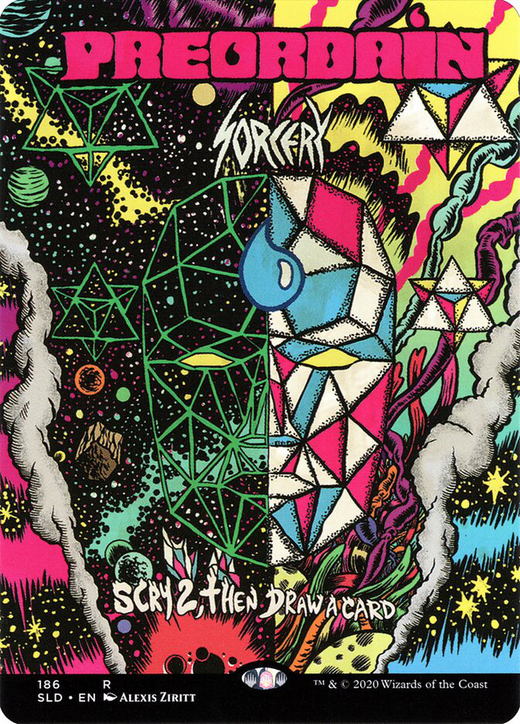
So creating a Superdrop or even a series of one or two Secret Lair product drops with the intention of introducing cards to Pauper (basically making the drop symbol a common card symbol) would be another way to solve the problem of Pauper's subservience to Limited, and an extremely profitable option for Wizards, as these products sell themselves as highly collectibles.
That said, this is the option that I like least because Secret Lair is a very limited, expensive product and the inclusion of specific cards in Pauper without the availability increase could significantly increase the price tag of these cards, making the format even more expensive and creating an issue at its economy.
However, it's a crazy idea for an equally crazy product.
Regardless of the way in which Wizards took this action, I would recommend to the community that respond with their wallet and seek to support the product because, at the end of the day, Magic, a game by which we hold dear, it's still a product to be sold by Hasbro, and if there's a language Hasbro fully understands, it's money.
This was essentially the same advice I gave about Pioneer when they announced the Challenger Decks: The best way for a format to have more competitive and product support is for it to sell well and be well received by the public, and demonstrating that support is what opens up the initiative so that more products and more opportunities arise for a format.
What about Affinity?
As for Affinity, it's pretty clear that something needs to be banned because the archetype is too consistent to be countered by the rest of the format and considering that eventually bans do occur (and this can take a long while, given that Wizards took three months to resolve a format state that was much worse than the current one and took two or three weeks to temporarily ban Faerie Miscreant due to a bug), what are the angles by which direct intervention can be done?

The most recurrent argument is that Atog should be banned, as the deck does too much to need a card that became a free sac outlet, a two-card combo, and a threat that needs to be answered on its own.
By removing Atog, you remove the deck's inevitability, while also making Disciple of the Vault's interaction with sac outlets much slower, as well as ensuring that opponents no longer have to play around the possibility of a combo-kill in the opponent's turn, being able to use cards like Hydroblast more efficiently during the game.
Honestly, I think this is the likely option to occur, as the consistency and value added to Affinity currently means that it no longer needs to play around the opponent, which significantly increases the consistency with which the combo presents itself as a threat.
Ad

I could see Wizards banning Disciple of the Vault, which would be an unfortunate decision and whose practical impact would be less than necessary, as even if the archetype loses the chance of winning the match with combinations involving Makeshift Munitions or Atog, it would not be enough to deal with the main problem of the archetype: The consistency.

The indestructible lands cycle is a tricky case because there is no point in banning a specific selection of these lands, as the archetype can change its configuration to play with literally any three-color combination.
So, the only way to deprive Affinity of its consistency would be to ban all indestructible lands, a move I can't imagine Wizards making for a “premium” product like Modern Horizons II, as it would essentially be banning ten cards from a single set.

If we're talking about manabase, what are the chances for Wizards to take a path that has occurred on other occasions (most necessarily with Daze and Gitaxian Probe, I won't mention Gush because it was never a fair Magic card to begin with), and ban old cards to fix an archetype that has been made too strong by new cards, and in this case, I'm talking about Mirrodin's artifact lands.
It might seem a bit extreme, and obviously archetypes like Boros Monarch as well as Metalcraft decks would suffer significantly from this decision (but it's not like Boros Monarch has been a Tier 1 deck since Commander Legends), but I could see the possibility that, in case of a ban on Atog isn't enough, Wizards decides to make the decision to ban the five colored artifact lands and significantly slow down the archetype, essentially weakening it to levels never seen before with bans in the format.
I don't think it's the wisest decision at the moment to deal with the current problem, but I can imagine a situation where banning Atog isn't enough to get Affinity back to a healthy level, and it leaves no choice but to perform a severe and devastating blow on the archetype.

Another commonly mentioned option is to ban the “mini-cruises”, removing their ability to draw three or more cards each turn, but both Thoughtcast and Deadly Dispute can do very cool things outside Affinity, and with some lists switching to Reckless Impulse, I'm no longer sure if removing draw spells would be enough, or even the fairest ban.

In particular, I would ban both Atog and Disciple of the Vault to make Affinity a deck that needs to win the game through combat, or with more Makeshift Munitions activations than is normally viable, making it a potentially fairer deck and can be stopped by efficient removals and fog effects.
Maybe it's not enough, but it's a good start.
Ad
Conclusion
I believe that's all I have to say about Pauper, its current state, and the chronic spiral of issues that is constantly plaguing the Metagame.
Honestly, I think the community needs to discuss fewer bans and demand more care, recognition and attention to the format because no matter how many cards leave the format, the problem Pauper faces is chronic, constant and will only be mitigated when its mandatory bond with Limited is weakened, opening up opportunities for more efficient answers and better downshifts in other products.
We have an active community totally in love with Magic and common cards, and it is of great importance that we have our space in Magic and in Wizards' care as well, whether in the competitive landscape, as well as during the production of new products, and I believe this it's a point that we can all or should all agree on. If you're busy with studying right now and have a lot of writing assigments, contact studycrumb for the best possible solutions. They can help free up time that you can devote to your favorite game.
So, if you, like me, want to change how the format is managed and not have to deal with so many chaotic scenarios over and over again, our best bet is to demand more recognition for Pauper, a format that moved 142 players in a side event of MTG Vegas this weekend, where they competed for a Tropical Island.
And if a Pauper tournament is worth a Tropical Island, I suppose that means the format can be taken a little more seriously and with a little more consideration and respect, doesn't it?
Thanks for reading!




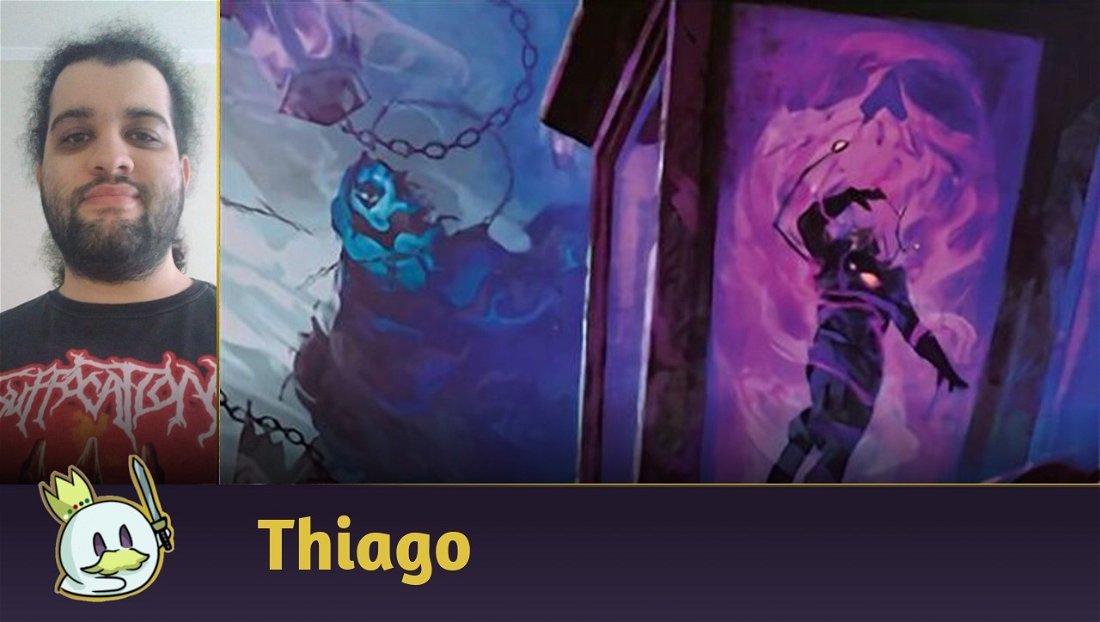
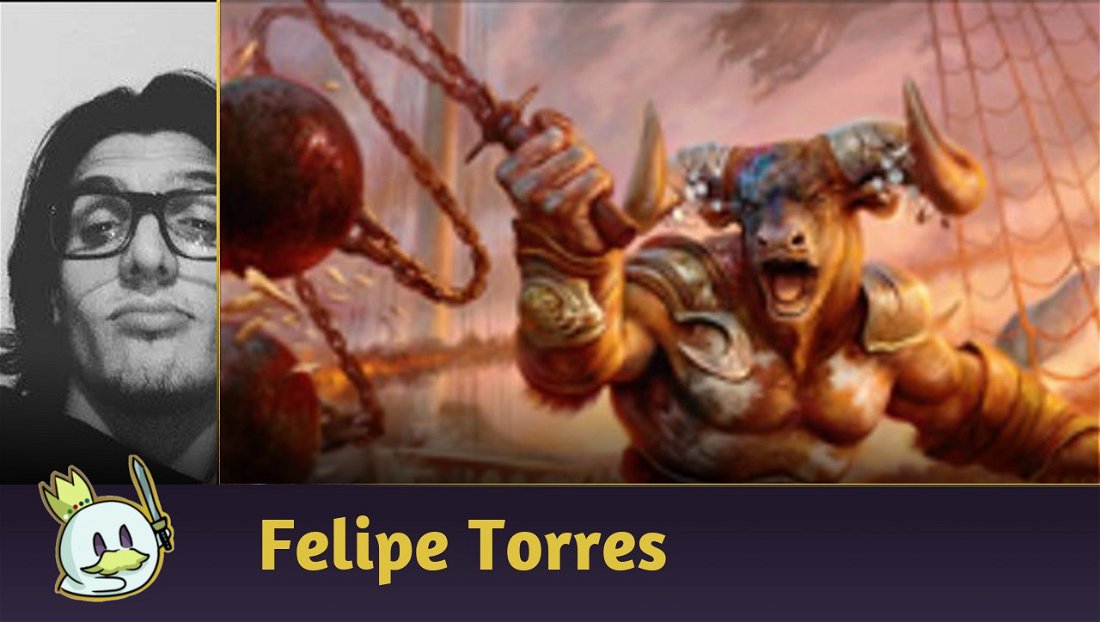



— Comments0
Adrian • 25/11/21
HumbertoMOD • 25/11/21
Be the first to comment